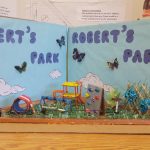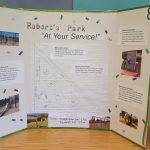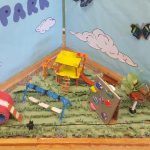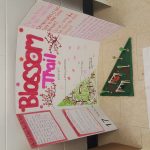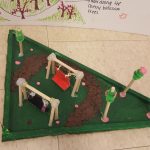- A continuation/expansion of TLC-16-149 (Technology)
- STEM Learning: Students will redesign and recreate a school area to enhance the learning community
- Students will use the Design and Engineering Process of understanding a problem, brainstorming solutions, choosing one solution, designing the solution, creating the solution using technology (computer programs/constructing a prototype), and analyzing and reflecting on designs and use of revision process
- School-wide initial event having students participate in a community walk, observing how mathematics was used in the design, investigating a school area that could be redesigned, a series of media, math and technology learning opportunities in classrooms, and culminating whole group of Grade 8 students to redesign area using science, math and technology
- Grade 8 students including students within Special Education programs
- Technology – use of GAFE for teacher, student and community collaborations
- Use of Google Draw and/or Sketch Up to design a space
- Based on feeder school EQAO data, students face challenges in the area of mathematics
- Based on school data, students and the community feel disconnected from one another, this project would support community cohesiveness
- Students will learn about their community and how they can use their voice/ideas to advocate for positive change
- Integration of a variety of curriculum areas and learning skills: language, mathematics, social studies, science, self-regulation, initiative, organization and responsibility
Team Members
Jeanette Timbury
Toronto District School Board
Kathleen Moll
Toronto District School Board
Trisha Kuma
Toronto District School Board
Cathrina Schoenfeld
Toronto District School Board
Gavin Chan
Toronto District School Board
Professional Learning Goals
- Increased use of GAFE for teacher collaboration and student learning
- Used technology to connect with one another and other communities
- Supported learning of mathematical content and skills, while integrating technology
- Used GAFE to develop and share three-part lessons to be strategically implemented and integrated in classroom instructions to support mathematical learning
- Learned about and used a variety of assessment and evaluation strategies including Assessment FOR, AS and OF Learning, using Google Classroom to allow for teacher-student descriptive feedback and peer descriptive feedback
- Utilized a variety of assessment strategies including pedagogical documentation to capture learning and support professional learning
- Deepened educator understanding of curriculum expectations and ways to connect curriculum areas
- Developed rich tasks that connect to a variety of curriculum areas and all areas of the achievement chart
- Deepened understanding of how to differentiate learning tasks to meet the learning needs of all students
Activities and Resources
- Team members
- Toronto DSB Google Apps for Education Help
- GAFE – Google Docs, Google Classroom, Google Draw/Sketch Up, Google Slides
- STEM resources for constructing
- Ontario Math Curriculum, TIPS4RM, EduGAINS
- Shared ideas during face-to-face professional learning, collaborative inquiry sessions to support the professional learning cycle of plan, act, observe and reflect
- Learned more about GAFE and how it can support teacher collaboration and student learning
- Investigated and utilized TDSB and ministry resources to support mathematics and technology learning
- Learned more about and used pedagogical documentation using technology to capture learning and used that as part of our professional learning
- Planned and developed a series of cross-curricular and integrated learning opportunities to support the inquiry and development of Geotricity 3.0
- Developed assessment tools for integrated learning tasks
- Developed open and rich tasks that can be differentiated to meet all learning needs
Unexpected Challenges
- Occasional teachers did not pick up all jobs; re-schedule caused the need for prep payback
- Needed to teach more about scale and story boards/pitch prior to the event
- Needed to re-visit mapping skills in geography
- More urban planning videos before the event; Ted Talks on urban planning
- More pre-teaching needed
Enhancing Student Learning and Development
- Students had the opportunity to engage in 21st century learning skills including collaborating with classmates and could connect with community stakeholders/Eco Schools
- Students became more familiar with features and uses of GAFE
- Students learned how mathematical thinking is applied in the design and engineering process when creating a community space/urban planning
- Students made real-world connections to the application of mathematics
- Students learned about Jane’s Walk and how to connect to their community by discussing how to create their own walk
Sharing
- Shared within the school with the Grade 7 teachers at a staff meeting
- Grade 7 students and all staff invited to a “Share Fair” to see the community designs and prototypes that the Grade 8s completed and to vote on the top three ideas
- Grade 7 teachers were invited into Google Docs to follow along with the process and contribute
- Geotricity 2.0 and 3.0 were shared with other area schools when possible; shared in a math learning hub
- Events and learning shared via Twitter, the trustee, and supervising prinicipal of instructional leaders
Project Evaluation
- Teachers and students are collaborated using GAFE
- Teachers and students explored how to get their project developed with stakeholder (Eco Schools)
- Improved Assessment FOR and OF learning in mathematics due to application of math learning and use of technology; lots of discussion about how to fine tune this and allow for individualized assessment as well; teachers made observations and filled in charts for Learning Skills
- Increased student engagement towards mathematics and STEM tasks
- Technology was used to support assessment
- Teacher and peer descriptive feedback as well as pedagogical documentation
- Team changed how to group students; grouped by jobs and skills to allow diversity. The groups were more productive but should have been chosen before the community walk as the groups were a bit big and less focussed. More information should have been shared about the culminating task before the walk to allow for more of a “buy-in.”
- Allowed students extra time from last year’s project and allowed them to take it home
- More engagement for struggling students; hand-over-hand was used for building
- Lesson development focused on cross-curricular and integrated learning
- A variety of assessment tools were created and utilized that connected to different curriculum areas and all areas of the achievement chart
- Learning was differentiated to consistently meet the needs of all students
Resources Used
Map of local community
MSIC STEM resources – Design and Engineering Process
https://sites.google.com/a/tdsb.on.ca/model-schools-for-inner-cities/units-1/units-2015-2016
Ontario Curriculum Guides
EduGAINS TIPS4RM
Jane’s Walk
Previous project
Resources Created
These resources will open in your browser in a new tab, or be downloaded to your computer.


